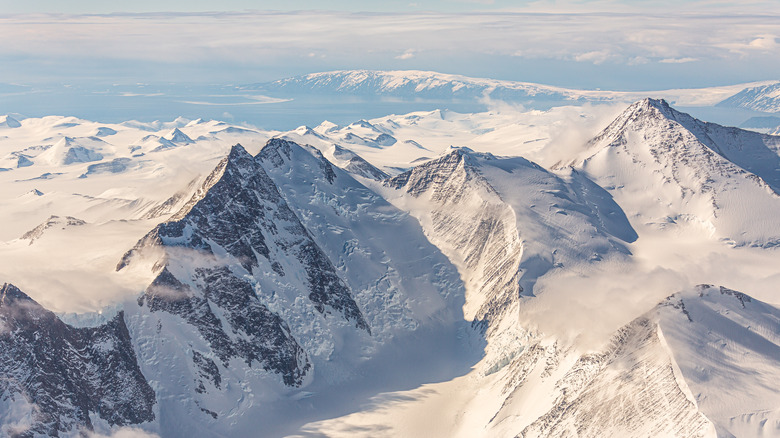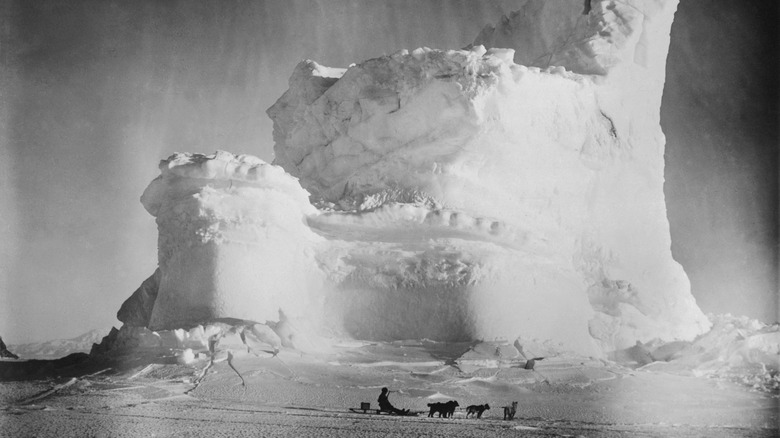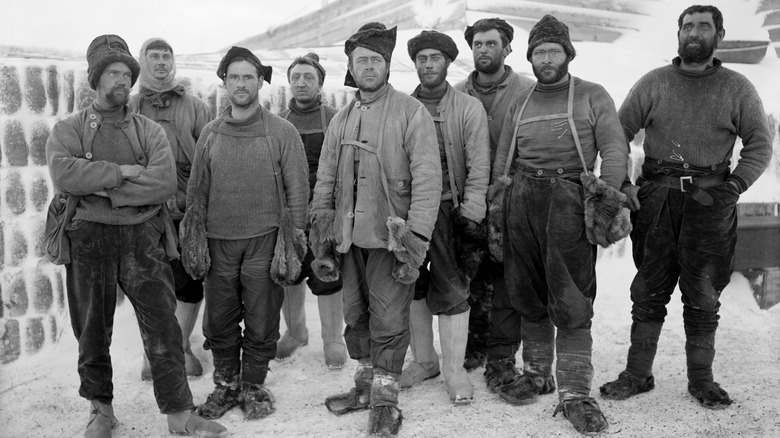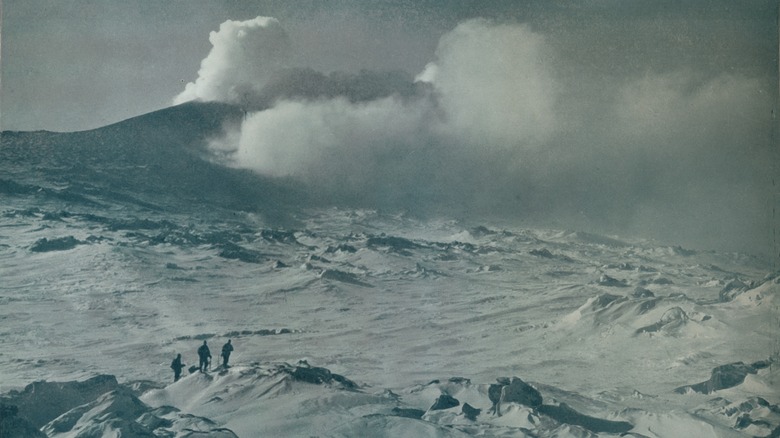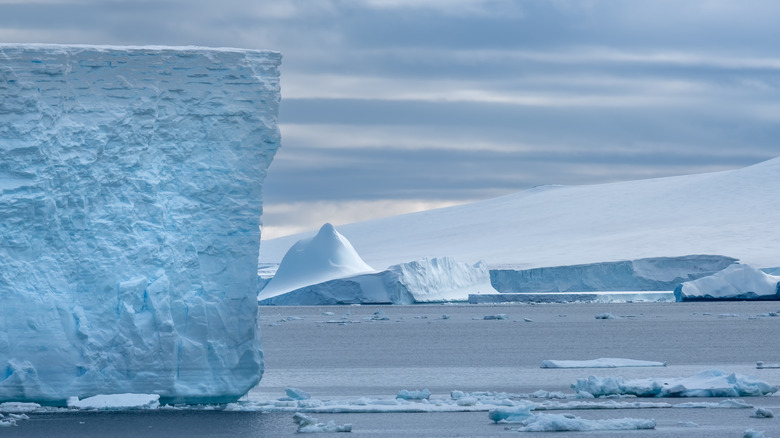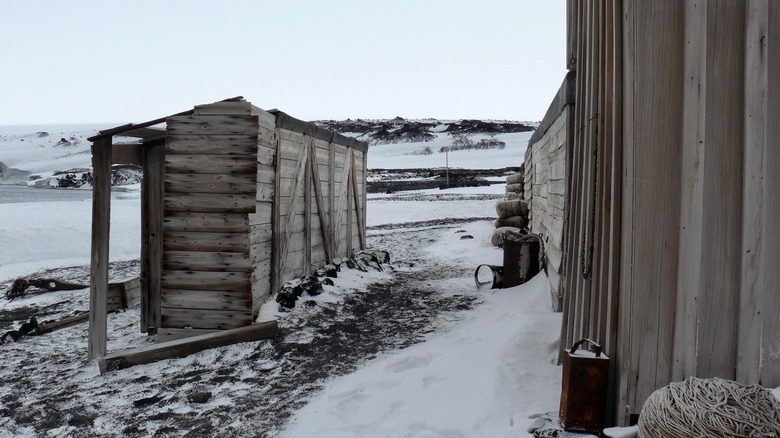5 Things In Antarctica That Can Be A Death Sentence
Antarctica, like the deepest parts of Earth's oceans, remains one of the planet's final frontiers. The entire continent is a stony, frozen, barren expanse of snow drifts, craggy peaks, and shifting glaciers. It's also a source of myth and legends, like allegedly housing Hitler's secret military base or having manmade pyramids under the snow. Then there's the mystery of the Piri Reis map, drafted in 1513 and referencing earlier, 2nd-century maps that seem to show Antarctica's coastline without ice. Even in fiction — like 1982's "The Thing" — Antarctica is a place of unknown dangers and lurking insanity. But speculation, discussion, debate, and fiction all agree with facts on one point: going to Antarctica is a death sentence.
Even to those with no further knowledge than "Antarctica is at the south pole," it ought to be clear why the continent is a tomb waiting to happen. Aurora Expeditions says that Antarctica's average year-round temperature — average, mind you — is 70 degrees below zero. Even taking melting ice sheets into account, the ice on the continent averages 1 mile thick and cloaks 98% of the entire region. That ice also accounts for 90% of all the world's ice. Antarctica's snow never melts, and it reflects sunlight so strongly that your skin will roast even as you freeze to death. The slightest misstep means the end: mechanical failures, improper supplies, failing health, snow blindness, bad weather, collapsing terrain, the madness of isolation, and more.
No natural resources
So what's at the top of Antarctica's death list? We'll put it to you this way: If you go on a weekend trip — just a weekend — what do you need to bring? Socks, underwear, shirts, pants, toiletries, toothbrush, maybe tweezers to pluck ingrown hairs, books and electronics, all your power cords, probably a spare phone battery, a couple packets of tissues, band-aids just in case, glasses or contact lenses, that little wipe cloth to clean the glasses, makeup supplies, jewelry, a little box for the jewelry ... you get the point? Now imagine that you're vanishing for months at a time, and there's not a single store to get anything you run out of or don't bring. You need all the food, water, fuel, utensils, plates, pots, cups, tins of coffee, towels to clean up, bags for your endless trash, etc. Also, there's no infrastructure, no electricity except by generator, it's 70 degrees below zero outside, and — wait a second — did you remember the toilet paper?
That's Antarctica in a nutshell. Take the Australian Antarctic Program's explanation of how each and every Antarctic station has a different, complex strategy for getting clean water and storing maybe 1.4 million liters just for winter. The BBC describes early Antarctic explorer Robert Falcon Scott dealing with the area's utter lack of natural resources, down to transporting wood to the continent to build shelter before his expedition died. So that can opener you forgot? Bye, bye life.
Equipment failure
It takes a special kind of person to step off a ship and onto the Antarctic continent — especially back when folks like Robert Falcon Scott sailed there in 1912. And yes, we said "sailed," as in: Scott and his full crew took the steam-supported sailing ship Terra Nova to the continent. After such a long, arduous, deadly journey even just to arrive at Antarctica, Scott wrote, "Great God! This is an awful place" in his journal, as the International Antarctic Centre quotes. He had no electric lights, no central heating, no GPS, and needed to build a base camp as an outpost just to drop anchor and survive.
This brings us to our second point: equipment failure. On one hand, as Live Science explains, not much has really changed when it comes to fundamental survival in Antarctica: clothing, shelter, food, etc. On the other hand, folks are much more reliant on technology now than in the past. We've got snowmobiles instead of dog sleds, computers instead of pen and paper, and full environmentally controlled research stations rather than wood-hewn shacks. So what would happen nowadays if a team experienced mechanical failure? This is why, as the Institution of Mechanical Engineers explains, fix-it-all genius mechanical engineers are vital to survival and success at the south pole. Everything from "helicopter radar rigs" to "underwater camera systems" need maintenance. If something critical fails, you're done.
Health and medical care
So you know that old advice, "You should drink such-and-such glasses of water per day"? That number needs a huge boost in Antarctica. The Baltic News Network recommends drinking 6 to 8 liters per day in Antarctica. This is because the air is so dry (the region is actually a desert) that you lose water just by breathing. You also need to eat 5,000 to 6,000 calories a day because it's so cold, and the body burns so much energy to stay alive. Some folks carry around loads of chocolate bars just to maintain proper calorie count. Aside from connecting to the dangers of not having adequate supplies, food and drink tie into being very, very careful about expending energy. Just to drive home the point about the body's fragility and unsuitability for living in Antarctica, The Kids Should See This says that a person can die of exposure in 3 minutes in polar temperatures, and boiling water will instantly flash freeze to ice.
Aside from bare-bones health, there's medical care. Mental Floss says that medical doctors in Antarctica are rare — sometimes one doctor presides over 150 people from a little treatment room. That doctor does tests, gives X-rays, takes blood samples, distributes medication, and even does dental work. But if something serious happens, or someone needs surgery, Country Reports says that a person will have to be evacuated by air to a hospital in a neighboring country; this can cost over $50,000. Ultimately, poor health and injuries in Antarctica mean doom.
Shifting ice and sun blindness
As if brutal, deathly low temperatures weren't enough, Antarctica comes equipped with some environmental features that make its terrain truly treacherous. The Baltic News Network describes how massive chunks of icy ground tend to split in half, or break off and float away, or just collapse altogether. Thinner ice usually looks darker, and is usually no thicker than 4 to 6 inches — this is sometimes called "young ice." The BBC describes how folks just vanish into crevasses in the Antarctic surface that you can't see and don't know are there until you're plummeting down to your death. Even if a crevasse or cleft is open and not covered with snow, it might be hard to see because of the roll of the terrain, or wind blowing snow in the air.
Then there's the weather itself. Meteorological predictions have gotten much more advanced in recent decades, but the weather in Antarctica is still very unpredictable. Within minutes, the Baltic News Network says, a bright and clear day can transform into a blustery snowstorm with winds up to 99 mph that can block vision. But if the sky is clear and sunny, that's dangerous, too. The Antarctic Heritage Trust says that people need special eye protection to shield themselves against the intense glare of ultraviolet light bouncing off of Antarctica's snow. Otherwise, someone can get snow blindness, aka "sunburn of the eyeballs," which Cleveland Clinic says lasts from a couple hours to a couple days.
Extreme isolation
On top of all of the physical dangers posed by Antarctica, those who venture forth onto its glacial surface face a foe just as ultimately lethal as any environmental threat: one's own mind. A study published in Acta Astronautica describes how those consigned to live in Antarctica suffer from the same consequences as those involved in long-duration space flight. Being in Antarctica, in other words — in a comparatively isolated, confined, high-risk, high-pressure situation — is psychologically comparable to not even being on Earth at all. Disturbingly, as ScienceDaily summarizes, those measured in the study exhibited no evidence of a "bounce-back effect." They were damaged — permanently — and even those elements of their work that previously caused joy produced nothing.
ScienceAlert reports on a related study in Frontiers in Psychology describing how those in Antarctica develop "winter-over syndrome," a type of "psychological hibernation" that serves as a defense mechanism to the extreme, relentless stress. And as anyone who's been in such situations will attest: They make you more prone to making mistakes — the kind of mistakes that, in Antarctica, will get you killed.
On top of everything else, down to the frostbite, the reader might wonder why anyone goes to Antarctica at all. And yet, as Stanford Medicine reports, some people go there year after year, and make it a normal part of their lives. But at least, per Forbes, there are no polar bears there to maul you to death.
